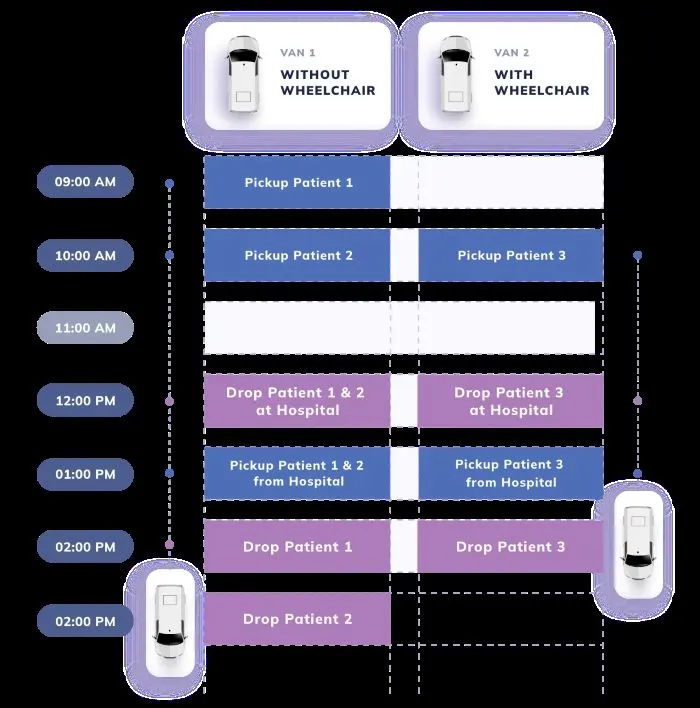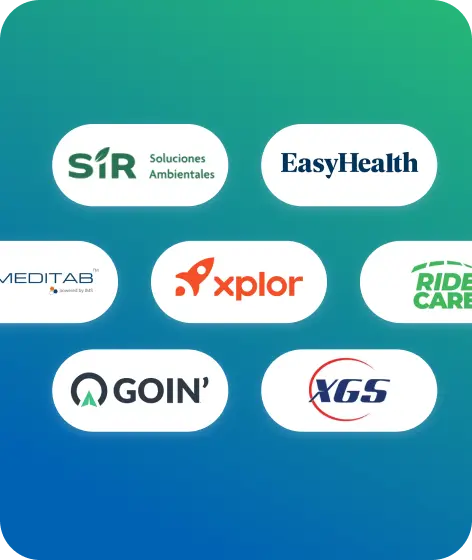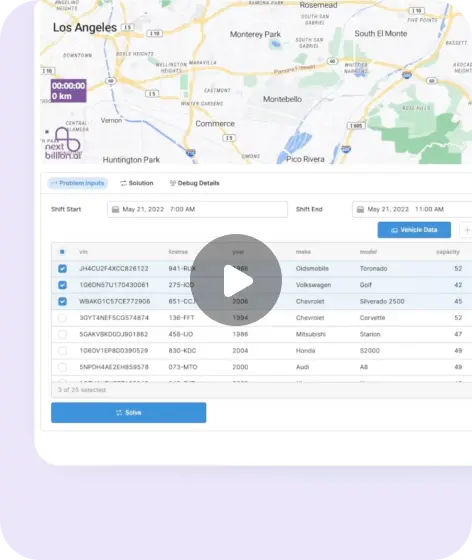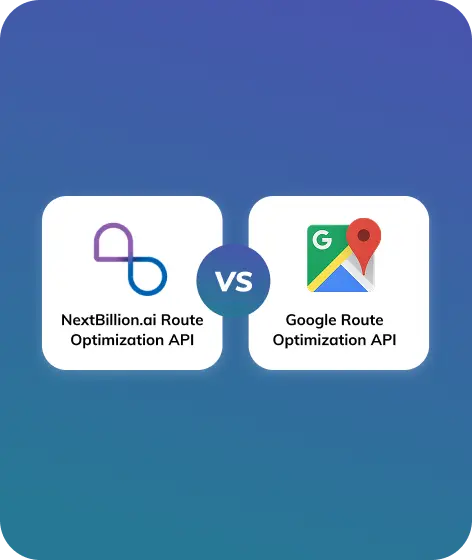
Table of Contents
Road mobility services for health support are gaining momentum despite an increase in personal vehicle ownership. Creative entrepreneurs seek potential in the medical transportation business, where they can assist people with health issues in their local or interstate movements.
Traffic, weather conditions, road networks, or fuel charges are among the few factors that directly impact the performance output in transit services. Leveraging optimum technology, though, helps in successfully expanding the business with customer satisfaction.
Medical transportation businesses serve at an individualistic level. Therefore, any delay in service, no matter how minor, directly affects the brand. We aim to provide comprehensive information about this sector, including its benefits, challenges, and how a technical suite can bridge the gap to achieve exceptional outcomes. Let us begin with understanding the main concept behind the medical transportation business.
Medical Transportation Business: Brief Note
Nearly a century ago, the availability of transportation facilities was minimal. It was almost impossible for patients in critical conditions to travel distances and seek medical aid from doctors.
Since there were few hospitals and clinics in a society, it was the doctors’ responsibility to visit the area and assist patients at their locations. However, it is not feasible for a doctor to travel with medical equipment and attend patients at separate locations.
The development of road networks and high-speed car engines paved the way for ambulances run by hospitals. Business minds foresee the potential in medical transport services and provide dedicated vehicles on call.
These vehicles are generally equipped with health support facilities like stretchers, and patients can board directly in the lying position.
The need of medical transportation business
There is indeed a dire need for a medical transit system. Many individuals who live alone and have health issues find it challenging to drive their own cars. Contrary to taxi services, clinically equipped vehicles provide convenience and safety during specific health scenarios.
Evolution in medical science has delivered cures for multiple diseases, and various new health complications are diagnosed each year around the world. Irrespective of how your body is troubling you, it becomes imperative to consider a medical appointment and visit the specialist for medication.
- Patients who have gone through surgeries or acute health conditions require continuous medical assistance, specifically during transit on roads. Therefore, we need a secure mode of transport that provides ample space for caregivers to accompany patients.
- Individuals with mobility impairments frequently use wheelchairs during hospital visits. They need ambulances, as public transport is not suitable for them.
- Old age problems are quite common, and patients often schedule appointments in clinics, diagnostic centers, pathology departments, hospitals, or rehab centers for doctor consultations. They strictly depend on medical transport.
Numerous events arise where individuals require a dependable medical transportation service. Therefore, companies and non-governmental organizations express a keen interest in initiating a medical transportation business.
A Quick Guide to Starting a Medical Transport Business
Initiating a business idea requires a lot of patience. We have curated the fundamental components you can follow to launch your medical transport business plan.
Competition assessment:
It is a crucial step before launching a business plan as you get valuable insights about the market and available options for the patients. You can evaluate the types of available services in specific regions, such as the number of semi- or fully equipped ambulances, taxis, their working conditions, prices offered, etc. Accordingly, you can develop effective strategies with unique options that offer greater value and quality for the end customer.
Demand analysis:
Analyze if there are any prospective requirements or trends in the market. It may be contradictory, but assessing the financial status of the population in certain locations can help determine the features you can offer. You can also find out details about the hospitals and diagnostic centres in the coverage area and the type of patients visiting.
Fulfill the legalities:
Every state has some customary legalities for starting a business, and usually the laws are strict in the healthcare sector. You must comply with all the regulations and apply for the license, as the whole process may take some time.
Crafting business strategy:
You need a clear vision about the company’s intent in the services offered and the unique selling points in the medical transport business. By now the target locations should be clear, alongwith the primary requirements and optimum solutions.
Finance arrangement:
With a strong business plan and well-researched strategy, you can confidently ask for bank loans. Perhaps the bank will charge you excessive interest in the long run, but to avoid this, partners can invest their personal income. Often other companies are interested in fruitful business plans that offer sponsorship.
Promotion:
This is an important part, as the potential customers should have first-hand information about your business services. Create social media profiles, websites, and digital or printed advertisements like pamphlets to spread the news and showcase the features. Network with hospitals and clinics for direct references.
Vehicle and equipment selection:
Depending upon the features offered and requirements, you can purchase a range of small cars to medium-size buses. Price them appropriately and be sure of the quality of the equipment attached to it.
Staff recruitment:
You need dedicated staff members so they can operate your business centrally. Learned drivers with valid documents and knowledge about the local region are always a plus. Depending upon the scale of the medical transport business, you need multiple such drivers who can serve in different shifts. Providing 24/7 facilities ensures greater credibility.
Integration of management tools and technology:
Your medical transport business would expand with multiple ambulances running across the region. So, it is imperative to integrate advanced software solutions for operational efficiency with optimized routes. Such tools are capable of managing fleets, assigning vehicles, or creating the fastest route plans, which is sometimes crucial in medical transits. Thus, it can accelerate your business strategies.
A thorough analysis of the above steps will ensure the successful establishment of a medical transport business.
Why should you invest in a medical transport business?
The medical transport business is highly profitable with consistent growth. The increasing population and various health issues diagnosed each year create a definite demand for trusted conveyance services.
- Continuous demand: Aging is a common factor among prospects who have clinical appointments for regular checkups. The least they need is a NEMT, or non-emergency medical transport, for home pickups and moving safely to a health care centre and back again.
- Various diseases and disabilities: There are many people who face mobility issues due to certain diseases or physical problems.
- Accessibility: The medical transport vehicles have greater accessibility into the town due to the motive and license they hold. Hence, many people choose medical transport for their scheduled doctor’s appointments.
- Government contracts: Often the government sector offers contracts to medical transport agencies. These opportunities enhance the brand’s credibility and help with more investment for business expansion.
- Reimbursement: Many insurance companies, hospitals, and diagnostic centres link with medical transport agencies and offer reimbursements, serving the clients in their transit between home and hospital.
- Societal impacts: Healthcare sectors genuinely have a positive impact on society. For philanthropic individuals, serving humanity gives immense satisfaction with trust building.
In-depth market research with a robust business plan works sufficiently in demand fulfillment and achieving financial goals.
Risk Factors in the Medical Transport Business?
It is obvious that the medical transport business involves a lot of responsibility, as there are people with critical health issues opting for these services for safe and smooth mobility. You should be careful about certain challenges to be more successful in entrepreneurship.
Vehicle standards:
The medical transit system is highly sensitive and responsible work, and therefore you should only use newly purchased or well-maintained vehicles. Tyres, shockers, engines, and other machines should be checked regularly to avoid jerks while riding. Patient’s safety should be the prime concern, and it may require a separate fund for maintaining the vehicle’s standard.
Trained drivers:
Ensure that the drivers are thoroughly trained and have an approved license to drive medical transport vehicles. They should drive safely with the ability to drive fast in critical conditions.
Compliances:
It is often tedious and time-consuming to obtain the license for healthcare-related businesses. So, make sure you have all the documents before the launch.
Accident safety:
Stressful situations can lead to unpredictable accidents. But a minor carelessness can tarnish the brand image, risk the patient’s and other riders’ lives, and damage the vehicle as well. Recovering from these events creates mental and financial troubles.
Fuel efficiency:
Fuel costs are continuously rising and often become a matter of concern when drivers had to wait in traffic or are unaware of the shortest and fastest route. Without optimized route planner software, it becomes inefficient and hectic to manage the medical transport business.
You may also need to invest in reputation management to deal with negative feedback from unsatisfied customers.
How to Promote Your Medical Transport Business
Medical transport business is not just about onboarding a number of vehicles on the route. You also need to advertise your business among the potential customers. Follow the latest trends to stay ahead of the competitors.
- Start with a website where you can systematically enter the details about your business. You can write blog posts, case studies, or upload pictures. Allow customers to write feedback or schedule ambulances for the next few appointments.
- Social media platforms are a great way to spread the information about your services and features. Add more users from local zones, and keep writing posts with pictures on a regular basis.
- Digital ads: You can also choose to advertise the business through Google ads targeting specific locations and keywords.
- Connect with the nearby healthcare facilities and ask them to refer your services to the patients or their attendants. You can provide pamphlets and stickers that showcase detailed features.
- A nice logo creates authenticity for your company’s brand, and people easily remember it.
Stable success is always gradual, and thus, a dedicated team can conveniently strategize the marketing tactics.
NEMT, Non-Emergency Medical Transport
You can choose to segment your offered services into NEMT or non-emergency medical transport business. It reduces the trouble of serving patients with severe health issues, and you won’t need to invest in installing critical medical equipment in the vehicle.
NEMT is the best option for people with health issues to make regular visits to the clinics and hospitals. The charges are less as compared to the emergency vehicles and efficient for moving to the hospital and back home.

Patients who have gone through routine surgery and have normal plaster due to bone fracture or injury can use non-emergency medical transport services. NEMT services are reliable and efficient in healthcare transits when patients had to reach medical centres for general treatments.
Should You Start NEMT Business: Investments and Profit
It is far more convenient to start NEMT business than initiating emergency medical transport. There are few parameters that you should fulfil while getting started with non-emergency medical services.
License and compliances:
State-wise, there are specific regulations for NEMT services. Eligible drivers should also possess a valid driving license. Medicare drivers are usually trained for general first-aid, wheelchair handling, and mechanics about the vehicle for instant repair in odd situations. Regular insurance and servicing of vehicles is crucial to prevent breakdowns while on the road.
Facilities:
You can configure the NEMT vehicles to slide-in patients on wheelchairs or stretchers. Many people prefer such vehicles as they are hassle-free and highly comfortable for bedridden patients or disabled persons.
Software solutions:
You need to integrate a software system that holds all the details about the employees and vehicles. An effective automation tool is capable of assigning vehicles to the drivers, creating optimized route plans, and much more. NEMT software serves for scheduling, tracking, routing, dispatching, and other such parameters.
Financial investments:
Medical transport vehicles are robust and expensive. You may need an office space depending upon the scale of business. Staff training is essential, and you also need to prepare for their salary payments. There are numerous other ancillary expenses, so it’s crucial to secure substantial funds from the market or corporate loans. Initial kick-start may take some time, so keep a backup for general costs.
Wealth creation:
Location is a prime factor that pays well in the NEMT business. Then price strategy, business growth, and fuel costs are the common factors that impact profit margin.
NextBillion.ai’s Route Optimization API for Medical Transport Business
NextBillion.ai has an advanced route optimization mechanism for NEMT and paratransit dispatch. Your medical transportation business can leverage multiple benefits with the NextBillion .airoute optimization API.
- You do not need to worry about vehicle allotment as well. The system allocates drivers based upon their skills and the requirements of patients, such as disability, bed-ridden, or normal health issues.
- You can enter multiple stoppages from the starting point, such as clinic, diagnostic centre, pathology, X-ray scan, medicine store, etc., and NextBillion’s API will instantly create an optimized route plan without human interference.
- It can optimize the vehicle’s space to manage wheelchair boarding, stretchers, and medical equipment.
- The tool also alerts about timely vehicle maintenance and manages equipment details with their working status.
- The automated route plans ensure stress-free drive for the vehicle drivers with a curbside support feature that smoothens patients boarding and disembarking. It saves travelling time for the patients with dispatch-ready routes, and quick pick-ups and drop-offs.
The NextBillion.ai route optimization API can integrate with all the database and ERP systems for swift management of your medical transport business.
To Sum Up..
Launching a medical transport business requires knowledge about the healthcare industry and the necessities of patients facing specific health issues while travelling for appointments. With changing scenarios and environmental effects, people are prone to diseases or otherwise have a higher probability of meeting accidents.
Medical transport or NEMT business is genuinely lucrative, and if you strategize analytically, it has the potential to generate commendable wealth. Utilize standard equipment, vehicles, trained staff, and software resources to efficiently and effectively manage your business.
About Author
Nitesh Malviya
Nitesh Malviya is a research-oriented professional with a background in Computer Science & Engineering. He served for 7 years as a software consultant and wrote passively in the tech niche before becoming a full-time technical writer.












